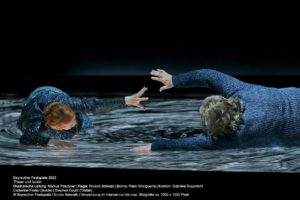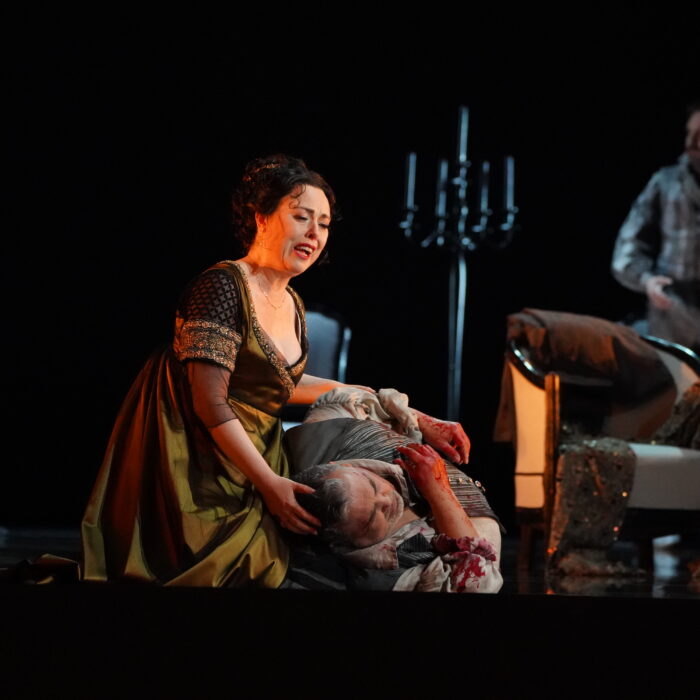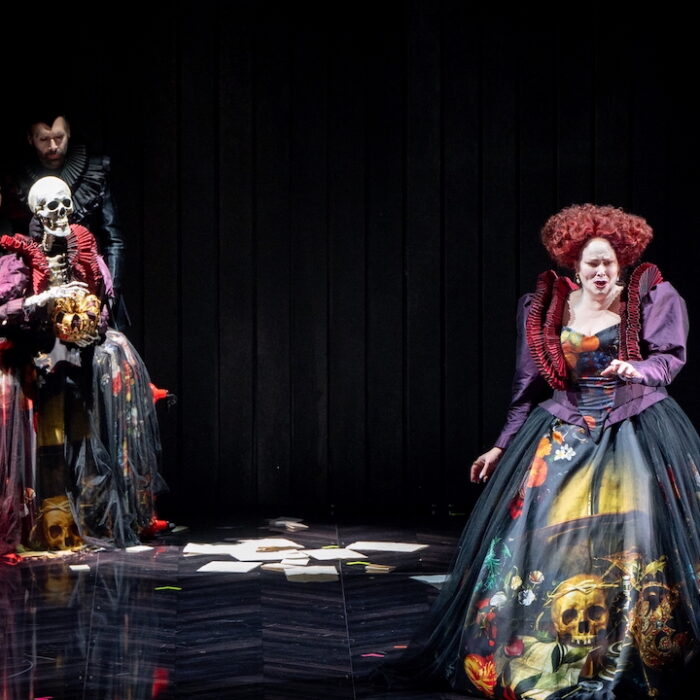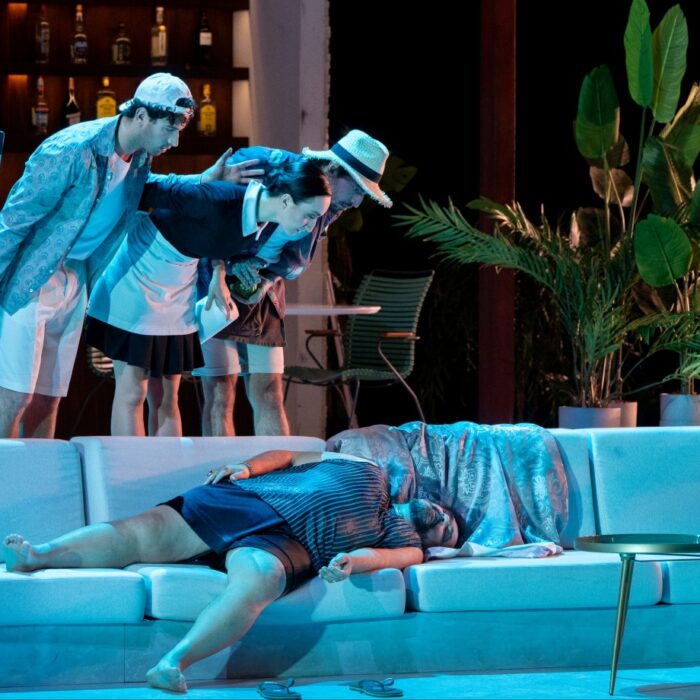
Bayreuth Festival 2022 Review: Tristan und Isolde
Catherine Foster Shines in Roland Schwab’s Beautiful Production
By Mauricio VillaWhile taking in a divisive production of “Der Ring des Nibelungen,” it was quite refreshing to take in the August 12 performance of “Tristan und Isolde” and come away hearing deserved bravos and cheers.
While most productions are usually planned years in advance, director Roland Schwab was only commissioned to take on this a new production of Wagner’s masterpiece in December 2021, leaving the creative team seven months to design, present the project, build the production, and rehearse it. And the result was a brilliant, meaningful production which, while modern, is respectful to the music and libretto. It’s also completely comprehensible, something rarely common nowadays in the world of Regietheater.
The set is a big oval chamber with an open oval on the ceiling and a central oval on the floor.Through the open ceiling we bear witness to projections of weather changes, depending on the action of the opera. Meanwhile, the floor oval represents another dimension, and the videos projected here show metaphorical elements like the sea turning red when Isolda talks about Tristan’s wound or a hurricane in Act two. There”s also a dark sky full of stars for Acts two and three.
But what’s most fascinating is that most characters can’t step on it or cross the floor screen; in fact only Tristan and Isolde stay on it. All the actions take place around this oval in Act one until the couple drink the “love potion” which is when they step into the oval for the very first time. They sing the whole love duet of Act two on it, but Isolde is violently pushed out of it by Melot when the couple is discovered, leaving Tristan in the middle, sitting on a chair as the oval turns black. Tristan is inside the oval for his agony and hallucinations in Act three, but as soon as Isolde enters he jumps out of it and it fades to black. He dies at the front of the stage as Isolde remains trapped at the back, unable to cross the central oval. Isolde finally steps back into it for the final “Liebestod.”
There is a wise use of the lighting, as designed by Nicol Hungsberg, with illumination changing according to the actions or emotions of the characters. The contrast between light and dark is constantly present with big shadows of the characters on the rounded walls, their silhouettes seen on the open ceiling or the back door, which is rather dark or illuminated in an impossible blinding white (depending on the several references to the light of the day or the darkness of the night). Schwab manages to find a perfect balance between the story, which can be clearly understood and all the philosophical/metaphysical concepts that are a constant throughout the opera, creating moments that have a realistic natural approach (the first act until they drink the “love potion” or Marke’s monologue in Act two). Meanwhile all the love scenes or Tristan’s suffering in Act three are staged with a symbolic theatrical language.
Finally, Schwab introduced his own concept of the stages of love in a human life by presenting a couple of children in the overture, a couple in their mid-30s for the second act and an elderly couple for the third act. In fact, the end of the opera, with this elderly couple holding each other at the very front of the stage as the curtain falls, provides a unique and alternate reading to Wagner’s poem. In the libretto, Tristan and Isolda are only truly united when they die, as this is the only moment when they can be totally free and love each other without conditions. But Schwab’s ending seems to posit for the immortality of love.
Whatever the correct interpretation is of this new ending, it does not betray the original source or make the story confused. It enhances it.
Tale of Two Lovers
Catherine Foster was a powerful Isolde. The British soprano has a big, dark sound with a marked but stable vibrato. Her timbre is completely round and even throughout her whole tessitura. Her sound widens as she rises to her higher range, something that was first noticeable as she delivered two thunderous big B naturals during her long Act one scene “Von einem kahn.” We heard this intense roundness again when she delivered two high Cs when the lovers are reunited in Act two.
Foster displayed unbelievable stamina required for this role as she finished the performance with an incredibly moving interpretation of the “Liebestod.” Her voice was fresh and the breath support was intact. Her characterization was intense but believable and she deftly portrayed all the extreme feelings Isolde goes through, from anger and revenge to unconditional love and ecstasy.
Stephan Gould sang the role of Tristan. This role, along with Siegfried, are probably the longest and hardest roles for tenor ever written, and the American tenor sang both of them at this edition of Wagner’s festival which shows his tremendous stamina and vocal technique. However, as I noted in my review of his “Götterdämmerung,” he has lost volume and harmonics in his higher register. Therefore his A flats and naturals sounded muffled and his vibrato became slow and unsteady. Wagner demands constant forte ascensions to A naturals at the most riveting emotional climaxes, such as the end of act one, the beginning of the love duet or the climax moments in Act three; in Gould’s voice, they sounded underpowered.
That said, Gould shined in lyrical sections such as “O sink’hernieder, nacht der liebe” or “So starben wir” in Act two and the calmer moments during his long scene in act three, where the vocal writing is central and demands legato singing. His last line:”Isolde!,” sung with hushed piannisimi, was breathtaking.
Solid Support
Ekaterina Gubanova was a brilliant Brangäne. Her lyrical instrument, with a dark, round sound but sweet timbre and mesmerizing projection, was the perfect contrast to Foster’s dramatic voice. She masterfully sustained the uncomfortable tessitura for a mezzo-soprano, with multiple sections written between E flat and A natural. Her interpretation of ”Einsam wachend,” which is on the most beautiful melodies written in this score, was extremely moving.
Bass Georg Zeppenfeld, who had appeared at “Die Walküre” as Hunding, sang the role of King Marke. He sang the expansive lines of his long monologue “Mir dies?” with exquisite legato line; the recitative sections were delivered with an immaculate German diction, offering a sorrowful interpretation of the betrayed king.
Markus Eiche’s lyrical baritone was ideal for the role of Kurwenal. He offered a strong characterization from the cynical and lively mariner in Act one to the hopeless friend in Act three. He effortlessly sang a strong high G in Act three upon realizing that Isolde is finally coming to Tristan’s side.
Olafur Sigurdarson, Syabonga Maqungo,Raimund Nolte and Jorge Rodríguez-Norton were brilliant in their supportive short roles of Melot, Junger Seemann, Ein Steuermann and Ein Hirt, respectively.
Markus Poscher offered an emotional reading of the score, giving special emphasis to the multiple crescendos and silences throughout. The overture begins with a short motif that concludes in the famous “Tristan’s chord.” This is repeated three times in different keys with three silences in between. Poscher managed to dilate the time of each silence to the extreme, creating a strong effect of tension. Moments like the aftermath of drinking the love potion or Tristan’s last “Isolde” before dying had the same effect. All of the leitmotifs were clearly expressed in the orchestra and all sections were completely balanced. The timbrical richness of Wagner’s orchestration was solid, but I consider that this interpretation relied strongly on the dynamics. The orchestra and chorus of the festival sounded beautiful, strong, and full of emotion.
Ultimately, this was a magnificent performance where the production, the cast and the musicians were excellent and therefore were correspondingly lauded by Bayreuth’s passionate audience at the curtain call, something which was rarely seen at this year’s festival.


